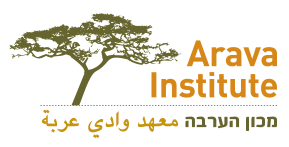
In July 2016 I left the Arava Institute after spending almost a year in this small, unique place in the Israeli desert as part of a group of Israeli, Palestinian, Jordanian and international students and interns. While there were some in our group who came from Germany, Brazil, Venezuela, and India, what was really unique was that the Institute brought together participants from Jericho and Jerusalem, Bethlehem and Tel Aviv. I myself had been to Israel many times before, but had never had the opportunity to interact with Palestinians on a real human level. In a part of the world where decades of conflict have kindled feelings of mistrust, fear and hatred of the other side, it’s rare to encounter organizations that foster cooperation and dialogue.
The Arava Institute has five research centers, and my internship was with the Center for Hyper-Arid Socio-Ecology. As an intern I was able to work on a range of projects, including monitoring acacia trees in wadis throughout the Arava, contributing to academic articles, and mapping the ways in which people use and value open spaces. Through my fieldwork and research I came to a deeper understanding of the ecology of the region, and the complex web of interactions between people and their environment.
More broadly, we were all collectively unpacking the ecology of the conflict, teasing apart and reassembling the biases and assumptions we previously held about those on the other side. Ecology, in the most basic sense, is the study of the interactions between organisms, as well as the interactions between organisms and their environment. To approach the conflict through the framework of ecology requires building relationships, and complicates notions of fixed boundaries and borders. It necessitates operating on all scales, from the single person to the larger community.
Through the Peace-building Leadership Seminar, which was mandatory for all students and interns, we learned to both construct and communicate our own identities and narratives, as well as empathetically listen to the narrative of someone else, even if it conflicts with our own story. We came to see each other as individuals, rather than stand-ins for a larger identity group. It was by getting to know someone you previously feared as “Palestinian” or “Israeli” that you could acknowledge the humanity of those living alongside you.
The Institute is located on a small kibbutz in the desert, and although Israel is quite small in area, Kibbutz Ketura sometimes felt like it was a world apart from the center of the country, even otherworldly, the landscape surrounding the kibbutz resembling photographs of moonscapes or Mars. The desert can be an extremely harsh place, but it is also a place of incredible, unique beauty. Many people mistakenly view the desert as being barren, devoid of life. A fellow intern jokingly referred to it as “just a pile of rocks.” But that harsh, stark landscape, with sharp jagged rocks that chewed up the soles of my hiking boots, is actually full of tenacious plants and wildlife that have adapted to these severe conditions. The Arava is considered to be not just arid, but hyper-arid, so when it did rain it would have a transformative effect on the plants that manage to survive in this parched place. In particular, I vividly remember the rumex, a flower that blanketed the wadi behind the kibbutz in pink after a rainy season with unusually high rainfall, and the Jericho rose plants that would stay curled up for most of the year, but expand open in the presence of water.
Thus the desert, with its coexistence of harshness and beauty, was a fitting setting for my experience at the Institute and the relationships that grew out of my time there. We shared meals and music with each other, while also confronting the difficult realities of the conflict. I heard about peoples’ families and where they grew up, as well as stories about dehumanizing experiences of living under occupation, or living with the fear of terror attacks, or friends on both sides of the conflict who lost people close to them. We could have intense disagreements and then a few hours later have a beer together at the kibbutz pub.
When I first came to the kibbutz, the desert seemed like an indistinguishable, uniform landscape of rock and sand. As I began to hike regularly in the area I learned to navigate routes by recognizing specific outcroppings and patterns in the landscape. I remembered where to find the plant that could be used to make tea that smelled like peaches, and where to find pools of water after it rained. It is by getting to know the particular, peculiar details of a place that you value it enough to protect it. And it is by getting familiar with the specific idiosyncrasies of a person that you can recognize what is universal in everyone. Those on the other side of the wall or fence become individuals, instead of an unknowable mass.
We all had different motivations for coming to the Institute. Some students and interns come more for the academic experience, and some for the chance to live in this unique community. Some are drawn by an interest in politics and others are more interested in addressing the environmental challenges facing the region. Yet one of the primary things that I took away from my experience at the Institute is that so many conflicts, whether in the Middle East or elsewhere in the world, are really a messy entanglement of all of these issues. The Arava Institute operates under the basic assumption that solving environmental crises cannot wait for a political resolution to the conflict, and that working together on environmental issues can build trust and lead to cooperation on other issues. What has been done there for the last 20 years is an anomaly in the region, but it shouldn’t be.
Submitted by Miriam Grunfeld (Spring ’16 alumna)

